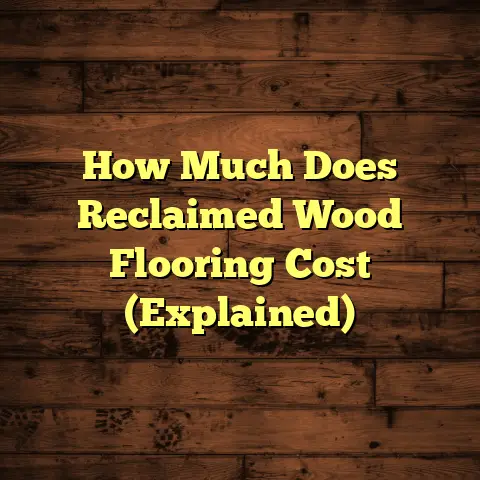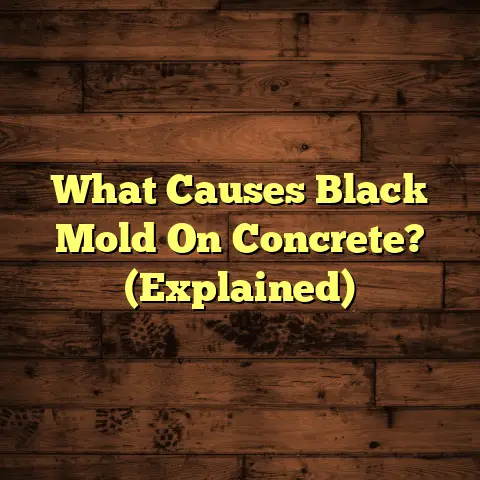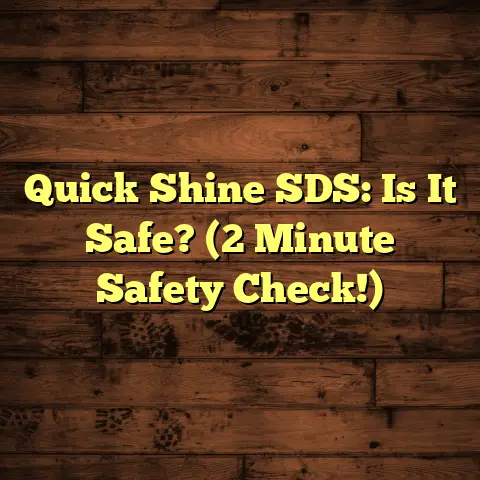Garage Floor Oil Stains: Easy Fixes? (3 Steps!)
Easy Fixes? (3 Steps!)
As a flooring contractor for over 15 years, I’ve seen my fair share of garage floors. And let me tell you, oil stains are a very common problem.Whether you’re a car enthusiast tinkering with your engine, a DIYer spilling a bit, or just a regular homeowner, those dark, ugly spots are almost inevitable.
They’re not just unsightly, either. Oil stains can be slippery, posing a safety hazard. Plus, they can decrease your property value and make your garage feel like a messy, disorganized space.
But here’s the good news: fixing those pesky oil stains doesn’t have to break the bank! I’m going to walk you through some cost-effective solutions that are actually pretty easy to follow.
I’ll give you a heads up on what’s coming.
In this article, I will share the secrets I’ve learned over the years to tackle garage floor oil stains. I’m going to share some simple and affordable steps to bring your garage floor back to life.
We’re talking about practical, do-it-yourself fixes that anyone can handle. Here’s a sneak peek:
-
Step 1: Preparation. We’ll cover understanding the problem, gathering the right materials (without spending a fortune!), and crucial safety precautions.
-
Step 2: Cleaning Process. I’ll introduce three effective and affordable cleaning methods, detailing the pros and cons of each.
-
Step 3: Prevention. We’ll discuss long-term solutions, protective coatings, and routine inspections to keep those stains from coming back.
So, are you ready to get started? Let’s dive in and reclaim your garage floor!
Step 1: Preparation
Okay, first things first. Before we start scrubbing, let’s get prepared. Trust me, a little prep work goes a long way in making this process smoother and more effective.
Understanding the Problem
How do these oil stains even form in the first place? Well, concrete is porous, meaning it has tiny little holes.
When oil spills, it seeps into these pores, making it difficult to remove. Common sources include:
- Leaking vehicles (we’ve all been there!)
- Spilled oil during oil changes or other maintenance.
- Grease and other automotive fluids.
The longer you leave the stain untreated, the deeper it penetrates the concrete, making it harder to clean. That’s why addressing the issue promptly is key.
Gathering Materials
Alright, let’s talk about what you’ll need. The great thing is that you probably have many of these items already lying around.
I’m a big fan of not spending a fortune on fancy cleaners, so I’ll give you some budget-friendly options.
Here’s a comprehensive list:
-
Absorbent Materials: Kitty litter (the cheap stuff works great!), sawdust, cornstarch, or even flour. These will help soak up the excess oil.
-
Cleaning Agents: Baking soda, dish soap (Dawn is my go-to), vinegar, or a commercial degreaser (optional).
-
Tools: Stiff-bristle brush (a scrub brush or even an old broom will do), a scraper or putty knife, gloves, safety glasses, a bucket, a hose, and a pressure washer (optional, but handy for tougher stains).
-
Protective Gear: Gloves, safety glasses, and old clothes. Trust me, you don’t want to ruin your favorite outfit!
Where can you find all this stuff? Local hardware stores like Home Depot and Lowe’s are great, and you can often find good deals online at Amazon, too.
Now, about those alternatives to expensive commercial cleaners. Baking soda is a fantastic natural cleaner and deodorizer. It’s also super cheap!
Dish soap, especially Dawn, is excellent at cutting through grease. And vinegar? Well, it’s a versatile cleaner that can tackle a variety of stains.
I’ve found that these common household items are cost-effective and surprisingly powerful when it comes to garage floor oil stains.
Safety Precautions
Before you start mixing chemicals and scrubbing away, let’s talk safety. I can’t stress this enough: safety first!
Here are some simple safety measures to keep in mind:
-
Ventilation: Make sure your garage is well-ventilated. Open the doors and windows to allow fresh air to circulate.
-
Gloves and Eye Protection: Wear gloves to protect your hands from chemicals and grime. Safety glasses will prevent splashes from getting in your eyes.
-
Skin Protection: Wear old clothes and shoes that you don’t mind getting dirty.
-
Read Labels: If you’re using any commercial cleaners, read the labels carefully and follow the manufacturer’s instructions.
Now, let’s prepare your garage space for cleaning.
First, clear out any clutter. Move your tools, equipment, and anything else that’s in the way. This will give you plenty of room to work and prevent tripping hazards.
Make sure you have adequate lighting. If your garage is dimly lit, bring in a work light or use a flashlight to illuminate the area you’re cleaning.
Step 2: Cleaning Process
Alright, we’ve got our materials, we’ve taken our safety precautions, and we’re ready to tackle those oil stains!
Now, I’m going to walk you through three effective cleaning methods. Each method has its pros and cons, so I’ll help you choose the right one for your situation.
Choosing the Right Cleaning Method
Here are three affordable and accessible cleaning methods for oil stains:
-
The Absorbent Method: This method is great for fresh stains or for soaking up excess oil before using another cleaning method.
-
The Scrubbing Method: This method is effective for lifting stains that have penetrated the concrete.
-
The Pressure Washing Method: This method is best for tougher, set-in stains.
Let’s dive into each method in more detail.
The Absorbent Method
The absorbent method is all about using materials like kitty litter, sawdust, or cornstarch to soak up the oil. It’s simple, affordable, and works well on fresh stains.
Here’s how to do it:
-
Apply the Absorbent Material: Generously cover the oil stain with your chosen absorbent material. Make sure it’s completely covered.
-
Let it Sit: Allow the absorbent material to sit on the stain for at least 24 hours, or even longer for older stains. The longer it sits, the more oil it will absorb.
-
Remove the Absorbent Material: Use a broom or a shop vacuum to remove the absorbent material. You may need to scrape it off with a putty knife if it’s stuck to the concrete.
-
Repeat if Necessary: If the stain is still visible, repeat the process. You may need to apply fresh absorbent material several times to completely remove the oil.
I really like this method because it’s so easy and doesn’t require any harsh chemicals. Plus, you can often find kitty litter or sawdust for cheap.
The Scrubbing Method
The scrubbing method involves creating a paste or solution that helps lift the oil from the concrete. It requires a bit more elbow grease, but it’s very effective.
Here are two variations of the scrubbing method:
-
Baking Soda Paste:
-
Make a Paste: Mix baking soda with water to create a thick paste.
-
Apply the Paste: Apply the paste to the oil stain, making sure it’s completely covered.
-
Scrub: Use a stiff-bristle brush to scrub the paste into the stain. Apply some pressure and scrub in a circular motion.
-
Let it Sit: Allow the paste to sit on the stain for at least 30 minutes, or even longer for tougher stains.
-
Rinse: Rinse the area with water and dry with a clean cloth.
-
-
Dish Soap Solution:
-
Mix the Solution: Mix dish soap (Dawn works great) with hot water in a bucket.
-
Apply the Solution: Pour the solution over the oil stain.
-
Scrub: Use a stiff-bristle brush to scrub the solution into the stain. Apply some pressure and scrub in a circular motion.
-
Let it Sit: Allow the solution to sit on the stain for about 15-20 minutes.
-
Rinse: Rinse the area with water and dry with a clean cloth.
-
With both of these scrubbing methods, the key is to really work the paste or solution into the stain. Don’t be afraid to put some muscle into it!
Also, make sure to rinse the area thoroughly afterward to remove any residue.
The Pressure Washing Method
For those really tough, set-in stains, a pressure washer can be a lifesaver. It uses high-pressure water to blast away the oil and grime.
If you don’t own a pressure washer, you can often rent one from a local hardware store. It’s a cost-effective way to tackle those stubborn stains.
Here’s how to pressure wash oil stains:
-
Prepare the Area: Clear the area of any clutter and sweep away any loose debris.
-
Apply Degreaser (Optional): For really tough stains, you can apply a degreaser to the area before pressure washing. Follow the manufacturer’s instructions for application.
-
Pressure Wash: Hold the pressure washer nozzle about 6-12 inches from the surface and spray the stain in a sweeping motion. Start with a lower pressure setting and increase it as needed.
-
Rinse: Rinse the area with water to remove any remaining oil and grime.
When pressure washing, it’s important to use the right nozzle and distance from the surface. A wider nozzle will cover more area, while a narrower nozzle will provide more concentrated cleaning power.
Start with a lower pressure setting to avoid damaging the concrete. You can always increase the pressure if needed.
Time Consideration
How long will each of these methods take? Well, it depends on the size and severity of the stain, as well as your own pace.
-
The Absorbent Method: Applying the absorbent material takes just a few minutes, but you’ll need to wait at least 24 hours for it to work.
-
The Scrubbing Method: Mixing the paste or solution and scrubbing the stain can take anywhere from 30 minutes to an hour, depending on the size of the stain.
-
The Pressure Washing Method: Pressure washing can take anywhere from 30 minutes to an hour, depending on the size of the area and the severity of the stains.
Keep in mind that these are just estimates. You may need to spend more or less time depending on your specific situation.
Assessing the Results
After you’ve cleaned the stain, take a look and see how well it worked. Is the stain gone, or is it still visible?
If the stain is gone, great! You’re done. If the stain is still visible, don’t worry. You can try repeating the cleaning process or trying a different method.
Sometimes, it takes a combination of methods to completely remove a stubborn oil stain.
If you’ve tried everything and the stain is still there, you may need to consider more aggressive cleaning methods or resurfacing the concrete. But let’s hope it doesn’t come to that!
Step 3: Prevention
Okay, so you’ve successfully removed those ugly oil stains from your garage floor. Congratulations!
But now, it’s time to think about prevention. After all, you don’t want to have to go through this process again anytime soon.
Long-Term Solutions
Here are some practical tips to prevent future oil stains from forming on your garage floor:
-
Regular Maintenance: Regularly inspect your vehicles for leaks and address them promptly. A small leak can turn into a big stain very quickly.
-
Prompt Clean-Up: Clean up any spills as soon as they happen. The longer you wait, the harder it will be to remove the stain.
-
Floor Mats: Use floor mats under your vehicles to catch any drips or spills. You can find these mats at most auto parts stores.
-
Drip Pans: Use drip pans under your equipment to catch any oil or fluid leaks.
By following these simple tips, you can significantly reduce the risk of future oil stains on your garage floor.
Protective Coatings
Another great way to prevent oil stains is to seal or coat your garage floor. A protective coating will create a barrier between the concrete and the oil, making it much easier to clean up spills.
There are several cost-effective options for sealing or coating your garage floor:
-
Concrete Sealer: A concrete sealer is a clear coating that penetrates the concrete and protects it from stains and moisture. It’s relatively inexpensive and easy to apply.
-
Epoxy Coating: An epoxy coating is a more durable option that provides a glossy, seamless finish. It’s more expensive than concrete sealer, but it’s also more resistant to stains and damage.
-
Polyurethane Coating: A polyurethane coating is another durable option that provides a flexible, scratch-resistant finish. It’s more expensive than concrete sealer, but it’s also more resistant to chemicals and UV light.
When choosing a protective coating, consider your budget, your desired level of durability, and the appearance you’re going for.
Routine Inspections
Finally, make it a habit to conduct regular inspections of your garage floor. Look for any signs of oil leaks or spills.
The earlier you detect a problem, the easier it will be to address it.
By being proactive about maintenance and prevention, you can keep your garage floor looking clean and stain-free for years to come.
Conclusion
So, there you have it! I’ve shared my expert tips and tricks for tackling garage floor oil stains.
I want to emphasize the importance of addressing these stains, not just for aesthetics but also for safety and property value. A clean, stain-free garage floor makes your garage safer, more enjoyable, and more valuable.
And remember, affordable, easy fixes are available to anyone willing to put in a little effort. You don’t need to spend a fortune on fancy cleaners or hire a professional contractor.
With the methods I’ve outlined in this article, you can reclaim your garage floor and make it a space you’re proud of.
So, what are you waiting for? Grab your gloves, your scrub brush, and your favorite cleaning solution, and get to work! You’ll be amazed at the difference you can make.
And remember, prevention is key. By following the tips I’ve shared, you can keep those pesky oil stains from coming back.
Now, go out there and conquer those garage floor oil stains! I’m confident that you can do it. Good luck!





